 |
The Hissem-Montague Family  |
 |
The Hissem-Montague Family  |

| Historical Timeline: Reign of Kings - House of Tudor
Historical Timeline: Reign of Kings 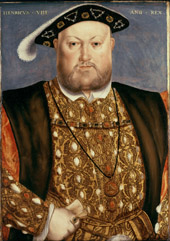 1509-1547 Henry VIII
1509-1547 Henry VIII
Henry made England a great nation that could deal on an even level with France and the Empire. However, he broke with the Catholic Church over his divorce from his first wife, Catherine of Aragon, the aunt of the Empereor. He then established the Church of England with himself as its head. Importantly, the north and west of England, being much more conservative than the cosmopolitan southeast, remained strongly Catholic in attitude and practice. Henry eventually married, and made Queens of, six women. Catherine of Aragon (the mother of Queen Mary), Ann Boleyn (the mother of Queen Elizabeth), Jane Seymour (the mother of King Edward VI), Anne of Cleves, Catherine Howard and Catherine Paar. The following rhyme tracks their individual fates: Divorced, Beheaded, Died. Divorced, Beheaded, Survived. While life at court was turbulent, Henry's reign was one of stability and growing prosperity for his people. The nation's population finally began to grow. |
(15) Unknown Heysham (c1540)
Of Warton parish, in the far north of Lancashire. As a guess, I'm showing the earliest Heysham in Warton to be the son of (14) John Heysham and a younger brother of (15) William Heysham of Highfield. I make the Highfield link simply because of its proximity, that is, it is closer than any other area where the Heyshams were known to have lived, being just 4 miles south of Yealand Conyers. Members of the family we currently know at generation (15) were:
(15) William Heysham (c1530), of HighfieldI have assumed that (16) John Heisham, below, could not be a direct link to the Highfield Heyshams because there was already a (16) John Heysham (c1570) living there, the eldest son of (15) William Heysham of Highfield, who was buried in Halton in 1613. He could, of course, be a son of (15) Gyles Hyshame, of Lancaster, but I've placed (16) John Highsame (c1575) as his probable son, and he lived his whole life in Lancaster, being buried there in 1637.
(15) Jane Heysham (c1539), of Highfield
(15) Gyles Hyshame (c1540), of Lancaster
(15) William Hyshame (c1550), of Lancaster
(15) Edmund Heysam (c1560), of Lancaster
Why would a son of John Heysham of Highfield move north to Warton parish? John's eldest son, William, got the farm. I'm just guessing here, but our Unknown Heysham may have come north to marry. That is, his father, always looking out for the welfare of his sons, had found a yeoman farmer who had, say 10 or 20 acres in Yealand Conyers, but no son to inherit it. Young Mr. Unknown married this daughter and inherited the property.
An Agnes Heisham was buried in Warton on 13 December 1585 - Warton Parish Register. She may have been the wife of Unknown. Contrarily, this could be the record of the death of one of his children, though most of those show them as "daughter of . . ." Heisham was a common spelling for the name of the village of Heysham in the latter half of the 16th century.
Historical Timeline: Reign of Kings
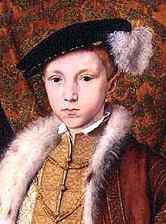 1547-1553 Edward VI
1547-1553 Edward VI
The son of Henry VIII and Jane Seymour, Henry's third wife. He was a sickly boy who died young. 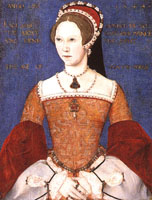 1553-1558 Mary
1553-1558 Mary
The elder sister of Edward VI, she was the daughter of Henry VII and Catherine of Aragon. Known as Bloody Mary, she made many martyrs in her attempt to re-establish the Catholic Church in England. She married King Philip of Spain, but they had no children. Calais, the last English possession in France, was lost during her reign. In this defeat England was finally forced to turn away from her dreams of an empire in Europe to that of a empire of the sea. |
Historical Timeline: Reign of Kings
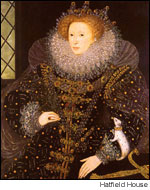 1558-1603 Elizabeth I
1558-1603 Elizabeth I
Called Gloriana. She was one of the greatest monarchs of all time, and was so attested by even her great enemy, the Pope. She brought the realm good government, good coinage, and, most importantly, peace. Her rule created the basis for the country's great leap forward in economics, military power and artistic achievement. After the execution of Mary, Queen of Scots, the Spanish King, Philip, sent the great Armada to subdue England and bring the country back to the Catholic faith. This force was destroyed in a series of fleet actions and by bad weather. The populace was exhilerated by this achievement. The first attempts were made to colonize America, but without success. In 1570 the population of England and Wales is estimated to be about 4 million. |
John Heisham is known through his daughter, Elizabetha filia Johis Heisham de Warton, who was christened on 12 July 1605 in Warton Near Lancaster. Warton was south of Yealand Conyers - a stepping stone from Highfield? John could have been born as early as 1555 or as late as 1585, that is, John could have been between 20 to 50 years old at the birth of Elizabeth. An earlier date could support his being the father of William, below, as well. This also implies that John could be a later son of (14) John Hesham of Highfield.
John Heisham of Warton was buried at St Oswald, Warton Nr Lancaster, Lancashire, England on 16 November 1622 - Warton Parish Register.
Historical Timeline: Reign of Kings - House of Stuart
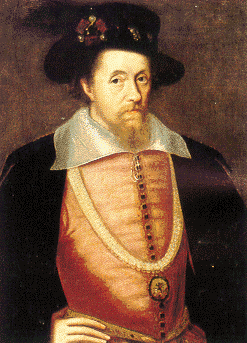 1603-1625 James I
1603-1625 James I
King of Scotland and son of Mary Queen of Scots. He gains the English throne through a sister of King Henry VIII. 1609 Henry Hudson explores Hudson and Delaware rivers for Dutch East India Company. English Colonies in Virginia and Massachusetts established. 1605 Gunpowder plot. |
William Heisham was christened on 7 July 1589 at St Oswald, Warton Nr Lancaster, Lancashire, England. There were no parents listed. "Sir George Middleton of Leighton and his Tenants in the Civil War Period" by Christopher O'Riordan, 1989, mentions the deposition of a Wm. Heisham in regard to acts conducted during the Civil War. Apparently William was a witness to the plundering of Leighton Hall in the 1640's for he deposed that "Two outsiders, Robert Troughton and William Gardner of Overton, took `two longe Tables' from Leighton for their own use" and "Two `outsiders' of Overton and three of Middleton (one a `gent.') took thirty-two oak trees worth a total of £5 6s. 8d." - from "Interrogatories and depositions in the case of George Middleton versus Jarvis Watson et al, 17 May 1653." This article gives an excellent portrait of Warton parish in the mid to late 1600's.
Historical Timeline: The Stuarts:
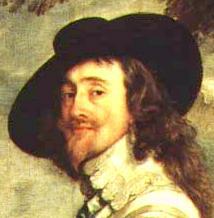 1625-1649 Charles I
1625-1649 Charles I
Charles was an ineffective King, stubborn when he should be conciliatory, irresolute when he should be strong. Religious conflicts accelerated and the Parliament, feeling its strength, confronted the King over its perogatives. In 1642 the English Civil War broke out. See The History Of The English Civil Wars for more information on this period. 1645 Sir Thomas Fairfax and Oliver Cromwell's Parliamentary troops defeated King Charles' army at the battle of Naseby. 1649 Charles I beheaded. Parliament proclaimed the Commonwealth. 1651 Charles II invaded England with a Scottish army to reclaim the throne. He was defeated and fled to the continent. |
The father of John Heesam. Richard was probably born in about 1617. This could be as early as 1597 or as late as 1627, that is, Richard could have been between 20 to 50 years old at the birth of his son, John, in 1647. His father may have been either John or William Heisham; both lived in Warton parish at the right time. If it was John, that could explain why Richard's first son was named John.
"de Yeala" refers to the village of Yealand Conyers, in far northern Lancashire, near the Lakes District. Richard, who is known only through the baptismal records of his children, was the father of John, who was baptized on 30 November 1647 in Warton, "John fillius Richard Heesam de Yeala" - Warton Parish Register. While the parish register was maintained at Warton, John was probably baptized at the church in Yealand Conyers. Note that there are two Wartons in Lancashire. One just west of Preston and the other just north of Carnforth. The latter is our village.
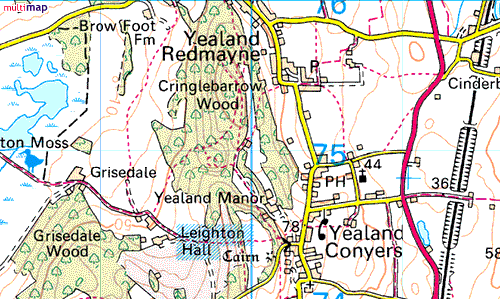
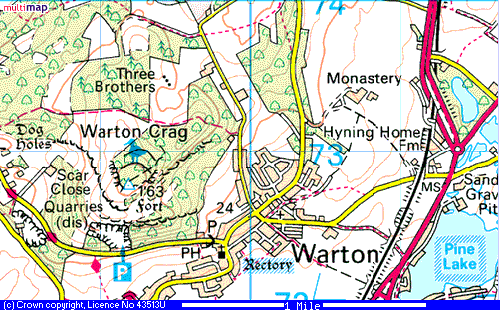
Richard would have been a young man, perhaps in his twenties, at the beginning of the Civil War when Lancashire was conquered by Parliamentary forces in 1643. He would have been deeply affected by the "leveling" of the classes that followed. Leighton Hall, just below Yealand Conyers, was the home of the local lord, Sir George Middleton. It was plundered by the locals. His tenants threw off his authority and refused to pay rents and tenure fines that would have otherwise been owed him. They also helped themselves to his timber, cut his turf, and slaughtered his deer.
The Restoration of the House of Stuart in 1660 resulted in the reassertion of aristocratic privilege, but did not necessarily change people's attitudes. What effect did this have on the emigration of Richard's son, John?
Other Heesam's of Warton Parish and the Vicinity
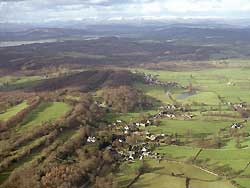
In the 17th century Warton Parish included, in pretty much a straight line from south to north, the villages of Carnforth, Warton, Yealand Conyers, Yealand Redmayne, and Yealand Storrs. Yealand Conyers, left, is on a plateau above Yealand Redmayne. About 4 miles southeast is Aughton and the Highfield estate of another Heysham family, and about five miles south is Halton. The generations listed below are approximations. (15) Robert Heisham (c1550) "Heisham, Robert, of Nether Kellet, Lancs. . . . Alleg. 1627" - from Index to Wills in Diocesan Registery, "A List of Freeholders in Cheshire." Nether Kellet is a township about halfway between Halton and Warton, in Bolton-le-Sands parish. The Highfields are just southeast. Also from the Diocese is a case between a Thomas Underwood and Ellen Key. There was apparently a child born to Ellen, which she claimed belonged to Thomas. Thomas saw it otherwise and brought in witnesses, of whom Robert was one. 27 July 1564. "Robertus Heisham, parochie de Weuerham [minister of Weuerham, in Cheshire], etatis lx annorum, novit partem actricem de puericia, et Elenan Key similiter.This appears to claim that a certain Elene Key, probably a minor, "did ride behinde a young man [evidently Robert] about Corvus Christi" and thus accept matrimony, or some such thing. (15) Agnes Heisham (c1550) "Heisham, alias Chambers, Agnes, of Bolton by the Sands, K . . . 1600" - from Wills in the Archdeaconry of Richmond. I assume this means that Agnes Chambers had married a Heisham, perhaps Robert, above. Bolton-le-Sands is just west of Nether Kellet. (17) William Heeshem of Warton (c1630) Possibly an Uncle of John Heesom. "Mr. Will. Heeshem" had two children baptized at St. Oswalds church in Warton Near Lancaster. These were Margret Heeshem, of Warton, and Geffory Heeshom, of Borwick. Will could have been a brother or cousin of Richard. A Gulielmus Heysham de B., also as Guliemus Heysham of Borwick, died and was buried at St Oswald, Warton Nr Lancaster, Lancashire, England on 26 February 1671/2 - from the Parish Register of Burials, 165301704. (18) Margret Heeshem (1661)(17) William Heeshem of Warton (c1630) The daughter of William Heeshem. She was christened on 1 November 1661, in Warton. There was a Margret Heeshem [Heesham] who married Leonard Jackson in 1690 in Lancaster, but I can't be certain this was her. (18) Geffrey Heeshom (1664)(17) William Heeshem of Warton (c1630) The son of William Heeshom. He was christened on 10 April 1664, in Borwick. "Christenings in 1664.The proximity of this record to those dealing with Yealand Conyers and Yealand Redman lead me to believe this was for the region near Warton. Borwick is a village just east of Warton. (18) Robert Heesom of Capernwray (1657) (17) William Heeshem of Warton (c1630) ?? Robert Heesom of Capernwray was born in 1657. Capernwray is just southeast of Warton, and the next village south of Borwick. Note also that it is just north of the Highfield estates of William Heysham (c1540) and his sons.
"Heesom, Robert, of Capernway (?) 1701" - from "List of the Wills Now Preserved in the Probate Court, Chester, From the Year 1701 to 1720 Inclusive." This may be a link to the Heesom family that became so numerous in Cheshire county in later centuries. His wife was Ann. Their children included,
(17) William Heeshem of Warton (c1630) ?? Alice Heysham was born in about 1655 in Bolton-Le-Sands. She married Robert Barker on 15 July 1676. She was buried on 3 April 1712 in Bolton-Le-Sands. (19) Richard Hessham of Warton (c1680) Richard must have been a successful farmer, or estate-man, in order to be able to afford to send his son, Thomas, to school for an advanced degree. (20) Thomas Hessham (c1710)(19) Richard Hessham of Warton (c1680)
". . . Hessham, Thomas, Adm. at KINO'S [Kings College?], c. 1345 [1745?]. Perhaps V. of age 17. S. of Richard, of Warton, Lancs. Scholar, 1733; Previously matric, from Brasenose, Oxford, May 13, 1727, Matric. 1734; BA 1735-6. Ord. deacon (Norwich) Sept 1734; Priest, July, 1736 . . ." - from "Alumni Cantabrigienses: A Biographical List of All Known Students, Graduates" by John Venn
Mary Heysham, spinster, married Francis Anderton, tailor, both of Sedbergh parish, on 12 April 1733 in Sedbergh, Yorkshire. Bondsman: James Inman, grocer, of Sedbergh. - from "Marriage Bonds for the Deaneries of Lonsdale, Kendal, Furness and Copeland." Sedbergh is on the borders of Yorkshire and Westmorland. Francis Anderton was born in 1700 in Sedbergh and was buried on 7 January 1740/41. This was Francis' second marriage. "Francis Anderton, of Sedbergh, clothier, and Eliza Tyson, of Birk Hagg, p. Kendal, spr." had married on 14 November 1721. Mary Anderton, widow of Francis Anderton, was buried on 2 December 1795 at St. Mary, Lancaster. Abode was listed as Lanc'r, but Notes indicated "from Warton." A Sir Francis Anderton of Lostock lived at the same time (1680-1760). He was a Jacobite, captured at Preston and tried for High Treason. His brother, Lawrence, received the estates, but upon his death in 1724 they passed to the Blundell family. The Anderton family lived in the Crosby district of Lancashire. They appear to have had the advowson of the vicarage of Garstang. I don't want to create a connection where there is none, but tailor or clothier does not have to mean someone who plied needle and thread. He could, like the draper Robert Heysham, have been a merchant tailor - selling cloth, not mending it. |
Richard Heesham "de Yeala" had a daughter, Allis Heesham, who was baptized on 2 December 1649. Richard Heesham "of Y. C." had a son, Allexander Heesham, who was baptized on 8 December 1653/4. Alexander, the son of Richard "of Y.C.," was buried on 19 February 1656/7 at the Church of St. Oswald in Warton Near Lancashire - all three citations were from the Warton Parish Register at Ancestry.com. Note that in this church register the town of Heysham was referred to as Heesham. Note also that the Heesham spelling of the name was also being used at this time by the merchant family of Lancaster. There was, however, another Richard Heesham who was living in Lancaster at this time, who may have been a son of Giles, the mayor of Lancaster.
| St. Oswald's Church, Warton
18 members of the Washington family, forebears of America's first President, were baptized there between 1584 and 1718. Robert Washington built the church tower and the family coat of arms are engraved in stone upon it. The church is proud of its association and flies the American flag every 4th of July. |
| St. John's Church, Yealand Conyers
|
"de Yeala" refers to Yealand and "Y.C." to Yealand Conyers, a village in Warton parish, Lancashire, 10 miles north of Lancaster. Note too that in the on-line version of the Warton Parish Register the "of Y.C." is rendered as "of Yealand Conyers."
| Yealand Conyers
Described as a "delightful village tucked away in the far north of the county . . . It is a treasure-trove of picturesque stone-built houses and cottages." North of the village of Warton, in the parish of Warton, are the Yealands, a sequence of three small communities named in order Yealand Conyers, Yealand Redmayne and Yealand Storrs. Their names derive from early Lords of the Manor, including Adam de Yealand, Robert de Conyers, and Henry de Redmayne. The Lords of the Manor in the 17th century were the Middletons. They had first appeared in 1438 when Geoffrey Middleton married Alyson Croft, the heir of the previous Lords. They eventually gained the manors of Yealand Redmayne, Yealand Conyers, Yealand Storrs, and Leighton where they lived, as well as lands in Silverdale and Lindeth. Bordering on the parish were their manors of Over Kellett and Burton, just over the county border in Westmorland. Leighton Hall, the Middletons' mansion home, contained twenty-four firehearths in 1664 when most of the other dwellings in the parish had only one. Leighton Hall was destroyed during the Jacobite Rebellion of 1715. The current building is of later construction. Yealand was held of the Duchy of Lancaster. During the Civil War the Middletons backed Charles I and the Royalists while most of their tenants were Parliament men, but even before then the yeomanry of the district, the rising middle-class, had fought with their Lord over customary rights and fees. After the war the battles continued, with the Middletons attempting to regain their feudal rights lost in the conflict. They were largely successful. In Quaker history Yealand Conyers is part of what is known as "1652 country," the region where the religion got its start in that year. James Fox, the religion's founder, preached in the village which resulted in a strong Quaker movement developing in the surronding districts. A meeting house, the earliest Quaker "church," was built there in 1692. The nearby Quaker school was also of very early construction. It was where Dr. John Heysham of Carlisle got his early training. See the Yealand Conyers Parish or the Lancashire Parish Portal web sites for photographs of the region. |
The strong Quaker environment in Yealand Conyers is one of the reasons I'm so drawn to this family as our possible progenitors in England. That Richard's son, John, would become a Quaker and emigrate to the first Quaker colony in America makes a good storyline.
Between 1661 and 1664 Parliament passed laws that effectively proscribed Quaker worship. Quakers were also fined or imprisoned for refusing to take a loyalty oath, since Quakers refused to swear, or pay tithes to the Church of England. The Test Act of 1673 accelerated persecution of the Quakers and led the sect's leaders to look for a sanctuary.
Richard Heesam de Yeala's children were,
(18) John Heesam (1647)
(18) Allis Heesham (1649), the daughter of Richard, was baptized on 2 December 1649 at Warton Near Lancaster, Lancashire.
(18) Alexander Heesham (1653), the son of Richard, was baptized on 8 December 1653 at Warton Near Lancaster, Lancashire. He died in February 1656.
Historical Timeline: The Commonwealth Period:
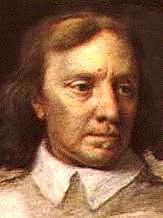 1649-1658 Oliver Cromwell
1649-1658 Oliver Cromwell
After the King was beheaded, and after a tumultuous period of Parliamentary rule, the leading general of the Puritan cause, Cromwell, was made Lord Protector. He ruled England through Parliament, but his absoute power over the Army made him a virtual dictator. 1658-1659 Richard Cromwell
|
John Heesam was born in Yealand Conyers, Lancashire and baptized on 30 November 1647 in Warton, "John fillius Richard Heesam de Yeala" - Warton Parish Register, 1568-1812. Warton's Anglican church was St. Oswald's. Note that Yealand Conyers had its own church, St. Johns, but its early records were kept by the parent-church in Warton. This probably means that John was baptized at St. John's, but the record of it were sent to St. Oswald's.
John would have been influenced from an early age by the Quakers, who were numerous in the area and vigorous in the early years of their religion. He may have become one of them. If not, then he at least was surronded by their debate in the 1670's about finding a place of refuge for the practice of their religion. This refuge was first identified in West Jersey and many Quakers left northern England for the Jersey colony starting in 1675.
Historical Timeline: Reign of Kings; Restoration of the House of Stuart:
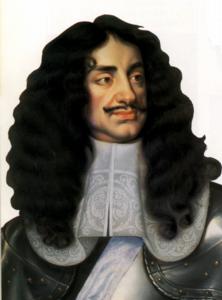 1660-1685 Charles II
1660-1685 Charles II
Charles II led a bawdy court famous for its royal mistresses. It was not famous of its intellect. Restricted in his income by Parliament, the King accepted money from France's King Louis XIV. Dutch colonies in America were seized and given to Charles' brother James, the Duke of York (hence New York city). 1665 - Bubonic Plague strikes London and 70,000 die. This was the last major outbreak of the disease.1665 - The Great Fire levels London (and frees the city of the plague). The Quakers found colonies in West Jersey and Pennsylvania in 1675 and 1682. |